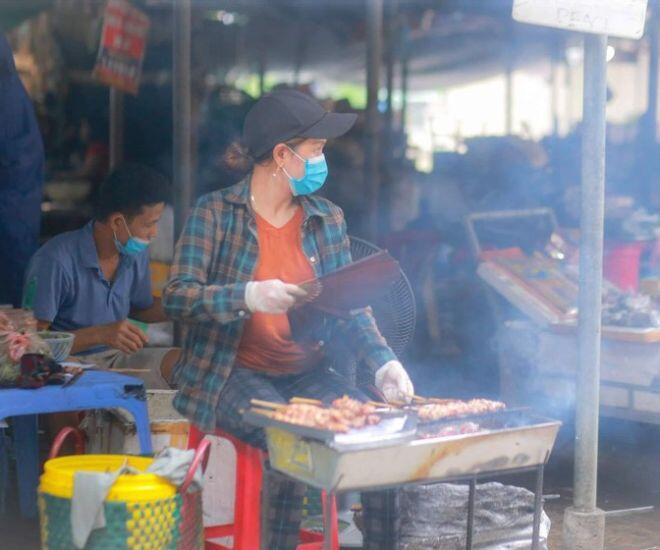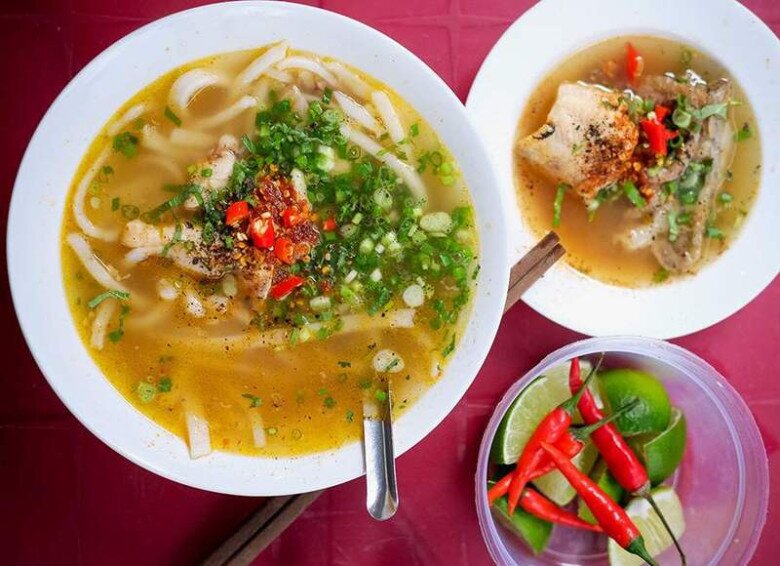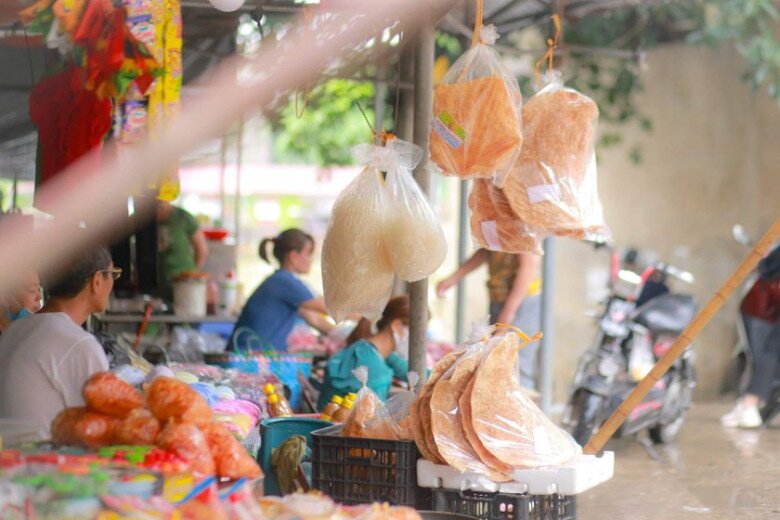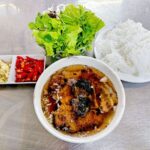The Ancient Market in the Heart of the Old Pottery Village
Located in the heart of the ancient Tho Ha village, about 50 km from Hanoi, Tho Ha market is situated on a small peninsula surrounded by the Cau River on three sides. Once a bustling center for pottery, the village can be reached by boat, with a short walk along the riverbank and a path lined with red-brick remnants of its golden age.

Tho Ha market is more than just a place for trading; it is a vibrant community hub. Every morning, especially on market days, locals gather to socialize and exchange goods. The lively atmosphere is filled with calls and haggling, creating a vivid picture of rural life.
The market offers a variety of local products, including Banh Da Nem (rice paper for spring rolls), Banh Da Nuong (grilled rice paper), rice noodles, rice wine, and agricultural produce. Tho Ha’s Banh Da Nem, known for its softness, elasticity, and fragrant rice flavor, has earned a 3-star OCOP certification. The village’s rice wine, with its distinct flavor, has been ranked 4 stars. Over 500 households in the village continue the traditional rice paper-making craft, and hundreds more make wine, contributing to the preservation of this ancient market and its heritage.
What sets Tho Ha market apart is the friendliness and warmth of its people. There is no hard selling, and customers take their time. Conversations over vegetables, rice, and wine are an integral part of the market experience, creating a unique and charming atmosphere.
Delicious Local Specialties Unique to Tho Ha Village
The market is also a great place to indulge in local specialties such as Chao Banh Canh (rice noodle soup), Banh Tai Meo (cat ear cake), and Nem Xao (stir-fried spring rolls). These dishes embody the essence of rural cuisine, offering a warm and rustic culinary experience.
Chao Banh Canh (Rice Noodle Soup)
Chao Banh Canh is a popular breakfast choice in Tho Ha. Every morning, small soup stalls in the market are bustling with customers enjoying this delicious and affordable dish. For just VND 5,000, you get a hot bowl of soup made with pork bone broth, shrimp paste, or shredded meat, combined with soft and chewy rice noodles.

Nem Xao Gon (Stir-fried Spring Roll Crumbs)
A unique snack to the region, Nem Xao Gon is made from the leftover bits of Banh Da Nem. Instead of discarding them, the villagers fry these crumbs with garlic and chili sauce, creating a tasty treat. Each bag of Nem Xao Gon costs only VND 5,000, and you can easily find them in the market or at the Banh Da Nem-making households.
Banh Khuc Tai Meo (Cat Ear Cake)
Despite its name, this cake is not made with cat ear leaves but with gai (ramie) or mướp (bottle gourd) leaves. It is a popular breakfast item in Tho Ha, loved by the locals. The process of making this cake is intricate. The outer layer is made from rice flour to ensure elasticity and prevent breakage. The flour is ground into a liquid, dried, and then repeatedly steamed and kneaded to create the perfect dough. The filling comes in two varieties: minced pork with wood ear mushrooms and onions, or salty mung beans with fat.
Banh Da Dua (Coconut Rice Paper)
Banh Da Dua is another beloved local snack, made mainly from pure rice flour. The process involves two rounds of baking: one without any toppings and the second with a mixture of sesame, peanuts, and grated coconut. After baking, the rice paper is dried and then grilled over charcoal, resulting in a golden, crispy treat. The aroma of sesame and peanuts, combined with the richness of coconut, makes this snack irresistible.

Visiting Tho Ha market is not just about shopping; it’s about immersing yourself in the local culture. You can try your hand at making Banh Da, learn about wine-making, listen to stories about the pottery village, or simply sit by the river, enjoying the peaceful atmosphere and the stunning sunset over the ancient village.
In the midst of modernization, Tho Ha market remains steadfast in preserving its unique identity. The local government and community have made significant efforts to restore and maintain traditional crafts, develop sustainable community-based tourism, and promote local products through OCOP certifications and organized tours. These initiatives not only generate income but also showcase the region’s cultural heritage.
Tho Ha village market is more than just a place of commerce; it is a link to tradition, a repository of memories, and an embodiment of local pride and identity. For visitors, it offers a glimpse into the soul of rural Vietnam—a simple yet profound, humble yet proud reflection of the local culture.
The Best Bun Cha Ha Noi Has to Offer: 5 Mouth-Watering Destinations Worth the Splurge
When in Hanoi, indulging in a bowl of authentic bun cha is a must. This iconic Vietnamese dish, a harmonious blend of grilled pork, savory broth, and delicate rice noodles, is elevated to perfection at these five renowned establishments. Though they may come at a higher price, the exquisite flavors and exceptional dining experience are well worth the splurge. Prepare your taste buds for a culinary journey like no other!
The Alluring Appeal of Vietnamese Cuisine: Liu Yifei’s 80 Million View Moment
“Chinese actress Liu Yifei, also known as Fairy Sister, caused a stir on Weibo when she was spotted at a casual Vietnamese restaurant in France, indulging in the famous pho. The rare glimpse into her everyday life delighted fans and once again brought Vietnamese cuisine, especially pho, into the spotlight in China.”



































